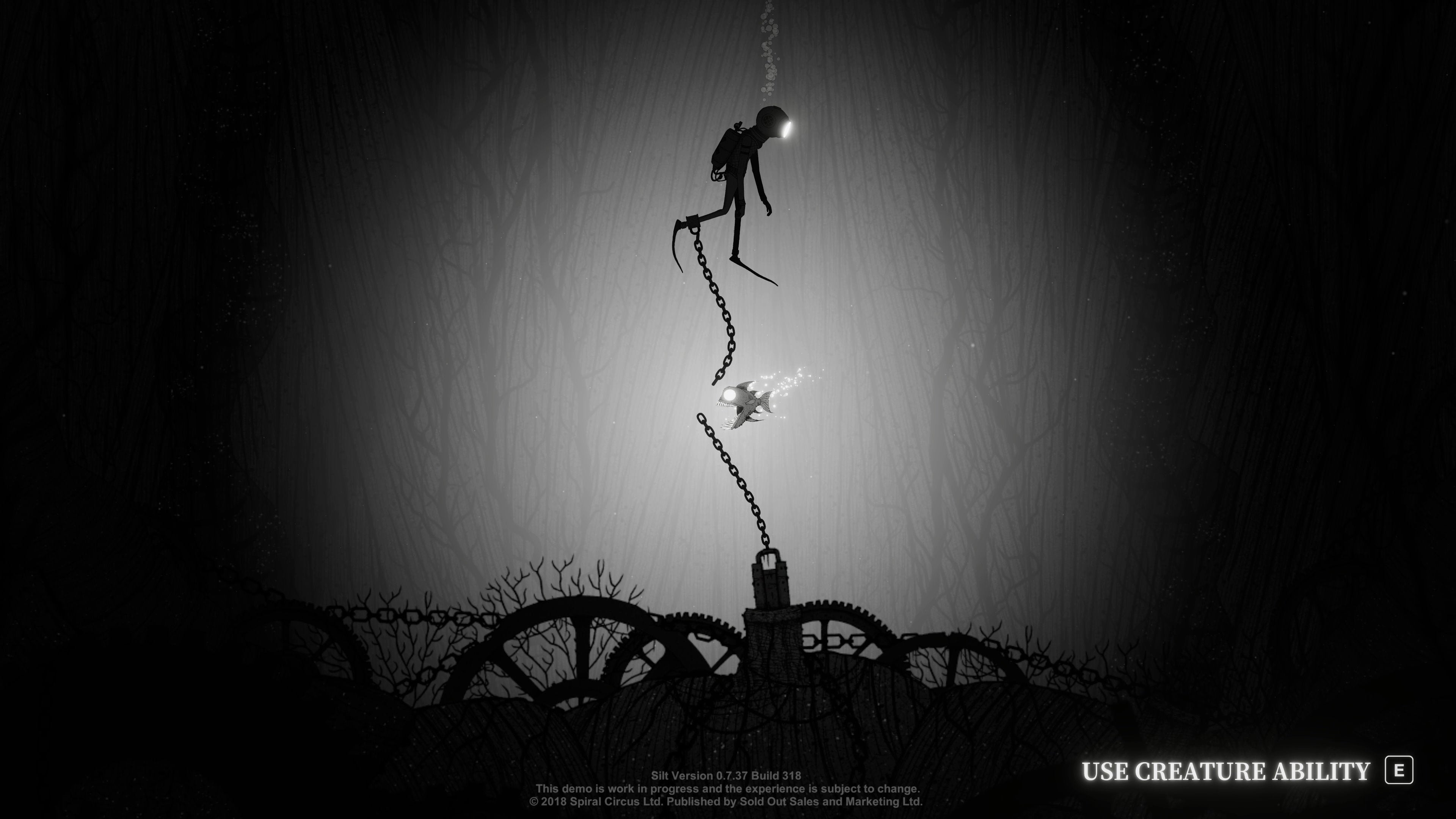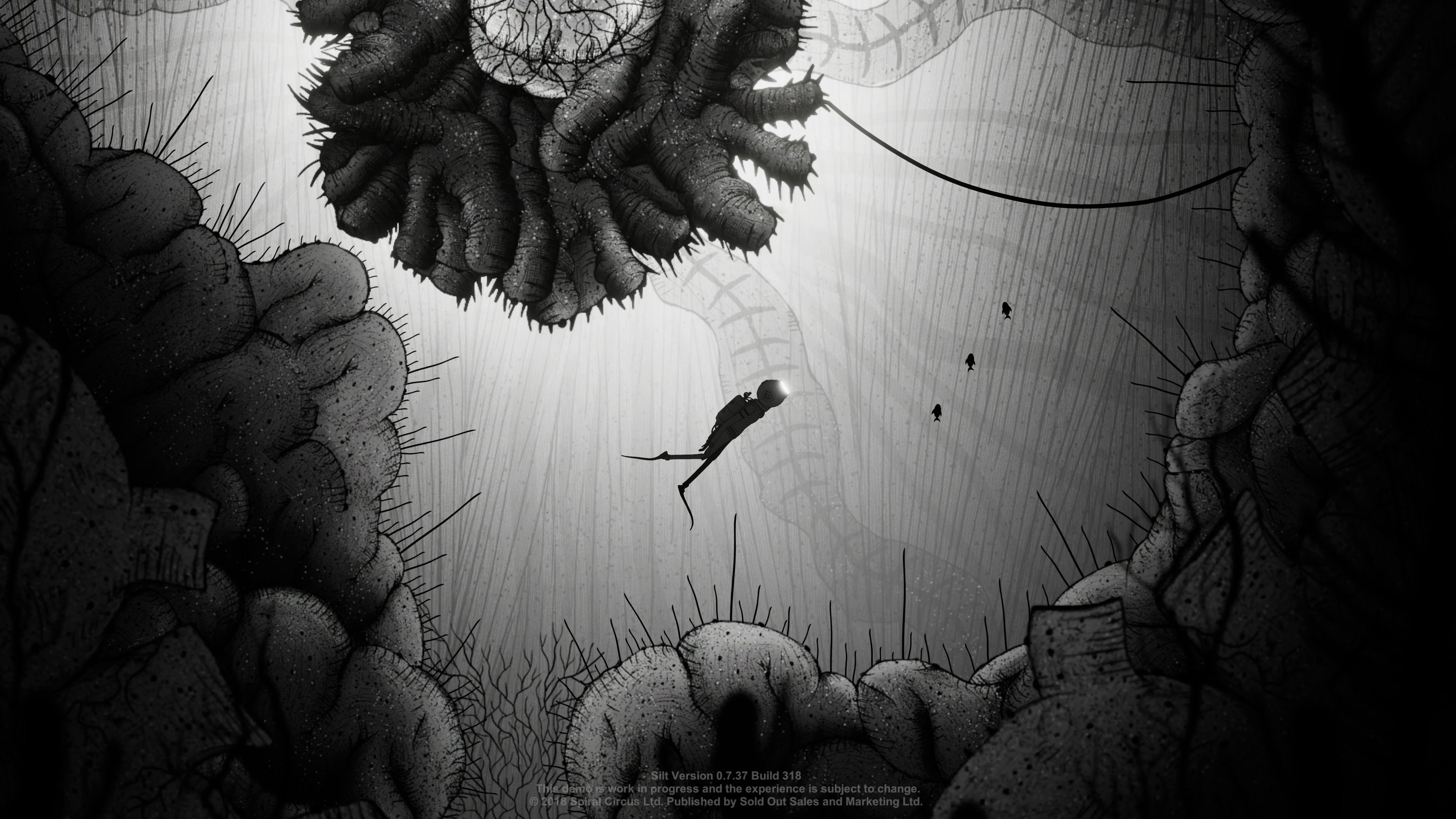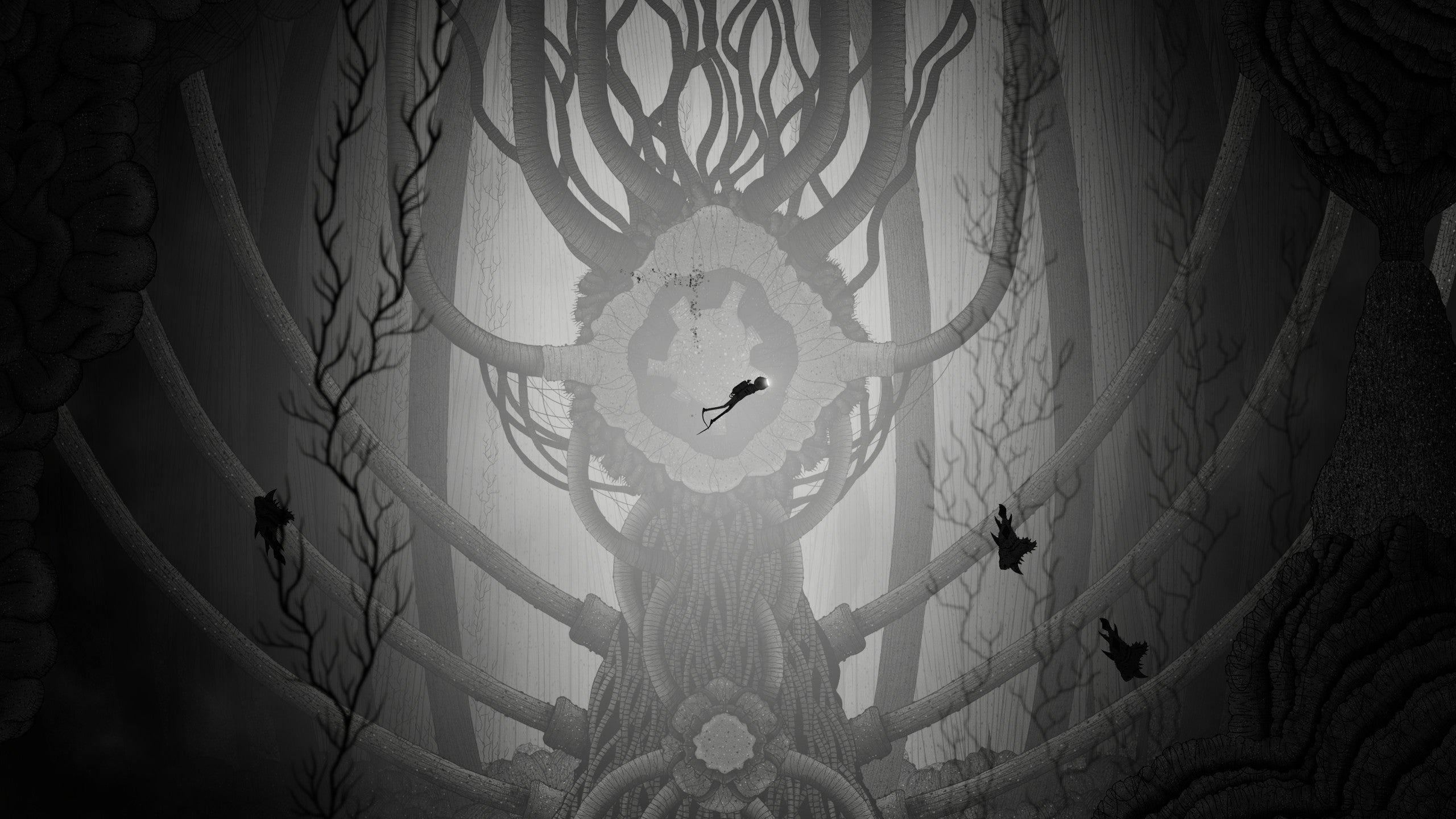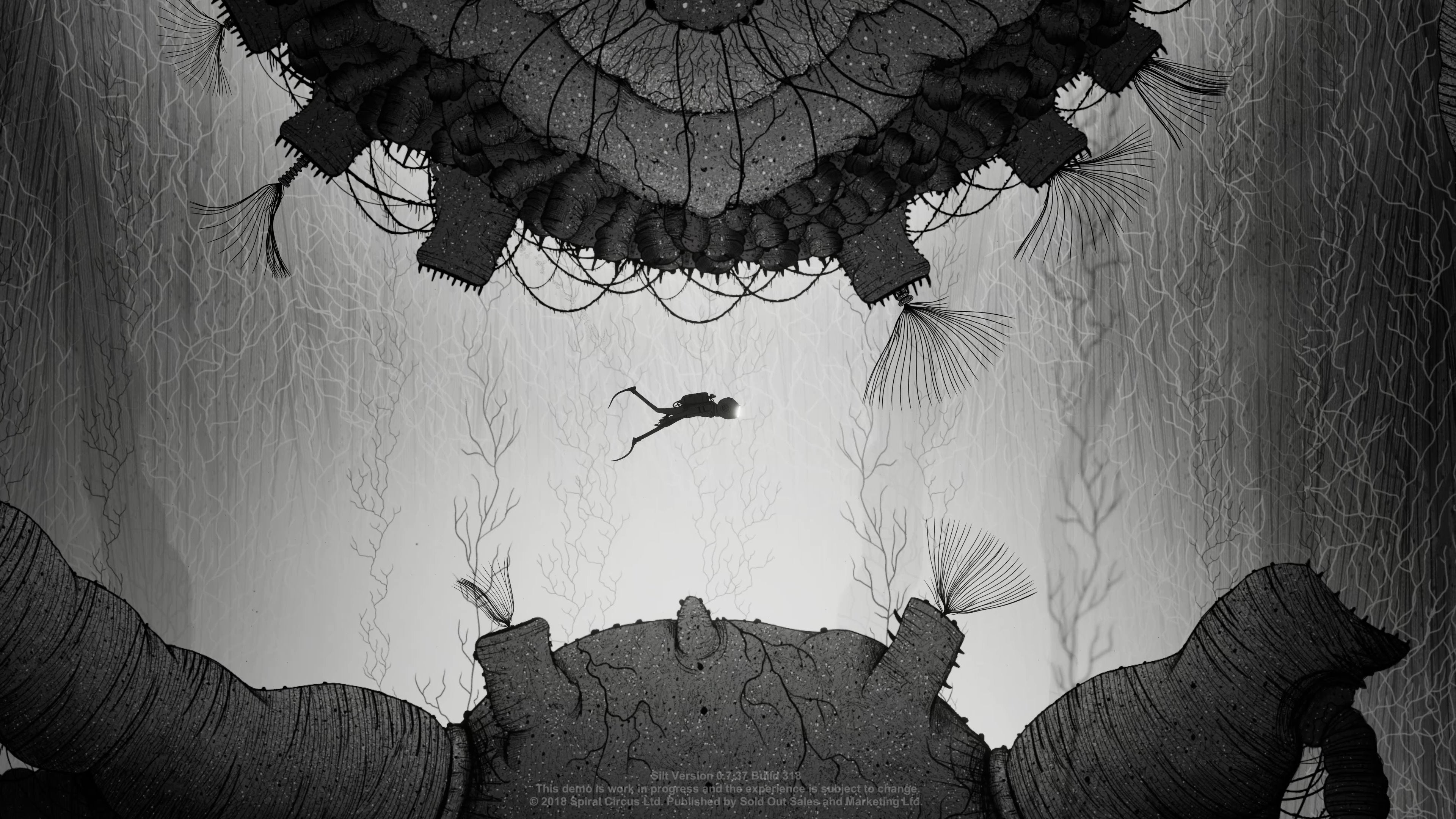“The main influence to any of my work is good old Beatrix Potter, believe it or not,” Mead continues. “I blame my mum entirely because she made me and my sister watch this horrible ballet when I was a kid, and I still haven’t watched it since then. Over the years, though, I realised that this was one of my main things that fuelled my characters, and the fox man character, I started drawing him and he became my main character for years.” Indeed, you may recognise Mead’s fox character from the last time he dipped his toes into game development with his short point and click project Foramina. Visually, this monochrome horrorscape has a lot in common with Silt, although Mead says he’s since learned how to adapt his detailed and time-consuming art style to something that’s a bit friendlier for making games in order to “basically not kill the project with my vast amounts of cross-hatching!” Alas, Foramina never made it further than that initial 2016 demo. “The scope was way too big for the team that we had, and the project got canned,” Mead revealed. Then again, his fox character has “travelled a lot over the years”, and having clapped eyes on some extra, currently unseen artwork for Silt during his EGX talk, you may well be swimming by some statues of him when the game launches on Steam early next year. It’s not just a fear of Beatrix Potter that’s fuelled the creation of Silt, however. Mead also speaks about being inspired by early Tim Burton, citing his The Melancholy Tale Of Oyster Boy as being a particular favourite, as well as pen and ink artist Edward Gorey and Australian illustrator Shaun Tan. But it’s his other great fear, thalassophobia - a fear of open water and deep underwater spaces - that really brought the game to life. “During that time [after Foramina], I ended up meeting Dom [Clarke], who is the other co-founder of Spiral Circus. He was a research scientist looking for an artist, and I was, at the time, looking for a programmer, so we met in the middle at exactly the right time. About two days later we were having a meeting discussing potential projects, and that’s when I started showing him my series that I was working on at the time, which was a watercolour series of my characters drowning in this big abyss.” As fate would have it, the drawing that caught Clarke’s eye the most was called “Silt”, and after that “we started working pretty quickly on it,” Mead continues. At this point, the pair also started discussing their game inspirations as well, and “unsurprisingly, one game that had a massive influence on both of us was Limbo,” he says. “For me, seeing an art style used to that atmospheric effect was really inspiring, and made me realise that my work was applicable to that kind of arena as well, which was good. From there, I started playing Little Nightmares and Samorost. Samorost is a bit lighter, but the drawn style of it was a huge inspiration.” I was able to sense all three from its EGX demo as well. The game begins with your diver awakening in a watery abyss, chained to strange mound of cogs and debris. Fortunately, there’s a small, sharp-toothed fish floating nearby, and you’re quickly prompted to ‘possess’ this creature by holding down Ctrl and guiding a spidery finger of light out of your helmet toward your quarry. With your soul now nestled into your aquatic companion, you’re able to chew through those chains to aid your body’s escape. Once you’re free, it’s time to swim upwards and find your way out of this eerie pit. But no sooner have you reached the next ‘room’, so to speak - a grisly, almost hairy chamber with some kind of beating organ ensconced in the centre of it - than you’re presented with another obstacle you’ll need to overcome. Heavy ropes prevent your diver from progressing any further, and the other way round this almost intestinal tangle of… something is far too narrow for you to pass through it. Once again, you’ll need to borrow the fins and flippers of a nearby school of tiny fish to get round it, wiggling in between the gaps until you can possess another one of those piranhas floating at the top of the room to chomp the ropes. The scenery only gets weirder from there. Before the 20 minute demo is over, you’ll have swum through a mass of delicate, almost filigree-thin plants surrounded by enormous, almost machine-like ducts of organic tissue and muscle, as well as what appears to be some kind of heart connected to a seemingly endless number of metallic tubes and cables in a deep, cavernous void. Then, as you break through the cracked, encrusted gullet wall with a bash of a not-so-friendly hammerhead shark, your diver suddenly emerges from the tooth-filled jaws of an enormous sea creature. As the camera slowly pulls back, the sense of scale on show here slackens the jaw, but quickens the heart. Thankfully, the beast is long-since dead, but when your escape route is held open by nothing more than a few hardened stretches of viscous spittle extending from the roof of its mouth, I wished my diver would flip his long, spindly legs just a tiny bit faster in case those sharp fangs came crashing down with a murderous thud. As you climb out of one beast, however, you can quickly find yourself in the belly of another if you’re not careful. In the next and final section of the demo, Mead and Clarke’s love of Limbo really comes to the fore, as your diver suddenly finds themselves drawn to a bright, shining light on the end of a wriggling tube. You follow it through a winding tunnel filled with other ravenous creatures that pursue you in their droves, only to suddenly break off as the tunnel opens up. I carried on following the light until it disappeared into a wall, but I saw the eager teeth emerging in its place too late. Down came another pair of enormous jaws, gobbling me whole and sending me back to the last checkpoint. I got my own back later on, but it’s clear that Silt isn’t going to be pulling any punches when it comes to unveiling the rest of its otherworldly nasties lurking in its depths. Indeed, Mead says that aside from Limbo, many of his other gaming influences all have similarly punishing retro sensibilities. “I played games heavily until I was about 16, and then I seemed to make the choice not to play as many games and focus on my art a bit more. Because of that I ended up with a kind of 20 year gap until I played games like Limbo. So my kind of reference points were all very old-school and retro. I used to love [1999’s] Shadow Man, it was one of the darkest games that I’ve played, really, and another huge influence on Silt as a project was Ecco The Dolphin, which I thought was a really creepy and strange game, which obviously I love.” In truth, Limbo meets Ecco The Dolphin seems like a pretty good elevator pitch, if you ask me, and one I’m certainly looking forward to playing more of when it comes out next year. Even though I’ve only been paddling around its monochrome depths for 20 minutes, Silt’s unique flavour of creepy nautical horror has lured me in hook, line and sinker. It’s the kind of place I can imagine writhing under the dark waves of Fallen London’s Sunless Sea, or as the deadly playground of Inside’s Ring-esque water maiden, and I’m intrigued to see how the rest of the evocative concept art and storyboards I saw during Mead’s talk will manifest itself in the game’s wider abyss. I also can’t wait to see what other fishy delights Mead and Clarke have in store for us to possess, too. There’s no sign of a terrifying Jemima Puddle Duck figure just yet, but given Mead’s history with Potter’s creations, you just never know. We’ll have to wait until early 2022 to see if our fears prove true.



